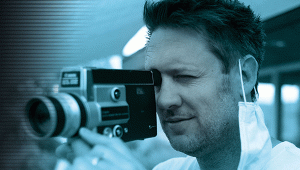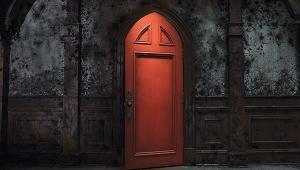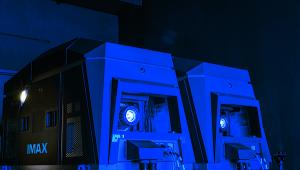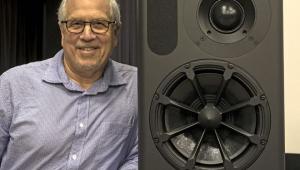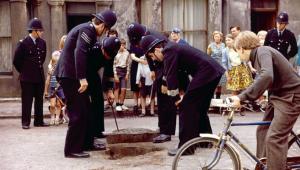The sound of IMAX
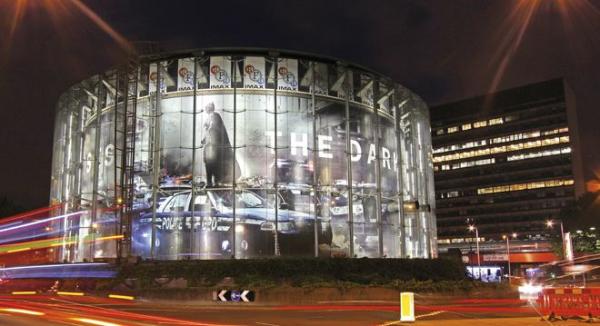
It all started with a disastrous screening at my local multiplex cinema, where I eventually had to complain about stifling heat, 3D trailers in a no-glasses 2D showing and a baffling system of seat allocation. And when the complaint yielded a grunted response, I began looking for another cinema for my business – and discovered that my local Odeon in Uxbridge had a new IMAX screen.
I came out from my visit very impressed – overwhelmed by the superb whole-field-of-view screen, tickled by the staffer who made a pre-movie announcement and, above all, blown away by the astonishing sound. Girthy audio at 118dB and deep, deep sub-bass means body-shaking, visceral wonder. And it's 'only' 6.1. I endeavoured to discover more about it – and, thankfully, IMAX's Chief Technology Officer, Brian Bonnick, was happy to help...
Do all IMAX systems have the same audio electronics and speaker setup?
'The answer’s sort of yes and no. Our theatres go as old as forty years now, so in our earlier systems, we have an earlier generation, so that part is "no". But the "yes" part is that they are all fundamentally based on similar concepts, with updates in the technology. All of our digital systems definitely all have identical systems.
‘The greater majority of our film-based systems have all been upgraded over the last few years. So, they are not at the latest revision of technology, being the second generation back. From an acoustical standpoint, it is one of the factors we take seriously. We want a customer to have the same sound and vision experience regardless of which theatre they go to.
'IMAX is a six-channel discrete sound system plus sub-bass. This means our soundtracks are custom-mastered to work with our theatres, with the filmmaker. In other systems, the cinema sound has to work at drive-ins and all other auditoriums on the one mix; the worst and the best. In our situation, it is mixed to a very specific standard, with ten times the dynamic range of other systems and our loudspeakers have the ability to take care of that.'
So, how deep can the speakers go?
'Our minus 3dB point is 20Hz. Yeah, it is very low. The loudspeakers, both the sub-bass and the full-range systems, are custom-designed and manufactured by IMAX. They are designed to fit our theatres. So we have separate systems, depending upon the room and its volume. We have different systems for different-sized rooms. The rooms are acoustically treated and we have a proprietary acoustical standard that works with our post-production audio mastering standard.
'We manage our sub-bass differently. All our speakers are full-range, even the surrounds. The amplifiers are made to our specifications, custom-designed for our environment.'
This might seem simplistic, as the building has to be part of it, but what is the cost of an IMAX screen, sound and projection system?
'We don’t sell a projection system, or a sound system, it’s always a full package and sometimes it is a joint venture with a client, so there are a lot of different factors in that equation.'
So what about the tuning of the room?
'That’s the ‘Secret Sauce’. In particular, with our digital systems, we have developed a new tuning system called NEXOS. It utilises the Audyssey MultEQ tuning algorithms but modified for us by Audyssey. It has gone well beyond MultEQ. We have exclusive rights for applications in cinema. We worked extensively with Audyssey to modify performance specifically for theatrical venues for the sort of volumes we are talking about. In addition, it uses our very own customised EQ curve, that we have spent forty years developing and optimising.
'Coupled with that is our own technology, which is patent pending. We employ permanently-mounted microphones in the theatre at numerous key locations.
'They collect real-time acoustic information that reports back to our Image & Audio Enhancer audio engine. It’s a super-computer with the power of about a hundred desktop computers. It does multiple things with audio and visual – it monitors performance, it can alert us to speaker degradation that happens with age. If a driver were to fail, it is capable of recognising that and through our network operations centre, which is connected to our systems via the internet, it will give us an alert.'
So if a woofer dies in Uxbridge, it’ll tell the computer back in Toronto that it needs to be replaced?
'Exactly. There are a couple of options, depending upon what the failure mode is. Say, a subwoofer driver has failed. We have the option of boosting the gain of the remaining subs temporarily, to bring things back in spec. In the meantime, we will send a service agent to replace the driver. A customer will be none the wiser.'
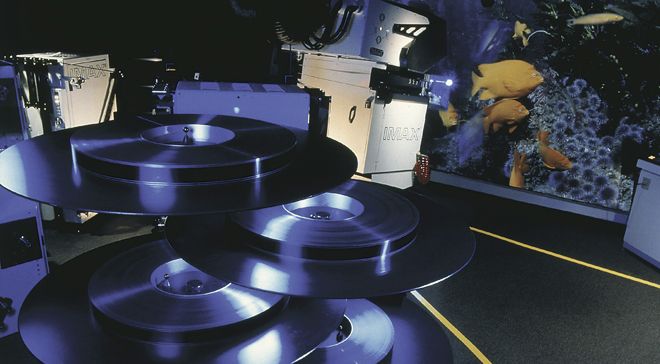
There was something else, about inter-continental remote control?
'Yes, movies are mixed to an 85dBc standard. [That’s eighty five decibels, ‘C’ weighted – it means pretty damn loud]. We want to make sure that everything is played back at 85dBc nominal, compliant to that. You are going to have films where the customer thinks it’s too loud and the theatre operator will turn it down. That happens and you have to allow that to take place.
The problem with that is the theatre operator forgets to turn it back up. So, for the next days or for however long, the soundtrack is not being played the way the filmmaker intended. Our network system has the ability to recognise whatever it is they have done. We receive that as an alert and typically before the next performance, they will have a phone call from us.
'We also have an optical-grade industrial camera doing the same thing for the vision. It looks at the screen as if it was your eyes. To be the best in the industry, we have to be able to maintain our systems. We monitor over 3,000 pieces of equipment. I can tell you the temperature of the processor on the motherboard of our main computer. I don’t use that data every day but it helps us with diagnostics.
'So, NEXOS gives us feedback and allows us to tune the theatre a little differently to how others do it. We use up to twenty separate frequency/time based readings, at hundreds of frequency points, not just thirty-one. We then allow the computer to manipulate that data but it is always verified by a human judgement, by an engineer, listening. All these things working together add up to the experience of hearing what the film maker intended to be heard.'
Dolby has released Atmos. Does IMAX have anything new, sound-wise?
'We are in development right now of our next-generation sound system, which is going to be a nine-channel system. It will still be based on discrete channel technology, with extra channels added in a very specific way. We are adding two more speakers on the side wall. So, in our environment, we have front left, centre and right, with another centre channel loudspeaker high up, we call The Voice Of God, as our screens are so tall. Then we have two rears.
‘We do not employ the use of surrounds, where you’ll have ten loudspeakers starting on the sidewalls and going all the way around the back. Primarily because that gives you a ‘wash’ of sound. You cannot pinpoint a sound from the array of loudspeakers.
'We use Proportional Point Source Sound technology. In most theatres, the ‘sweet spot’ hovers around the centre of the room. In our loudspeaker design, we take this into account and our horns emit greater energy to more distant seats and lesser to closer seats. By that, we manage to enlarge the sweet spot to cover the whole theatre, to within a dB.'
If we asked you what the crucial IMAX difference was, how would you put it?
'It’s not one thing that differentiates IMAX. If it was, people could copy that. We made a mistake many years ago, sort of a marketing thing, where we were quoting 12,000 Watts or 20,000 Watts. At that time we were marketing on the piece of technology, rather than the experience. It’s the sum of all the little factors. One of the big ones is that environment. We have taken a lot of interest in making sure the room is acoustically treated to work with IMAX.'
What about new build projects?
'We have a set of standard geometries – just the shape of the box. No walls parallel, like in a recording studio. We work with the exhibitor and their acoustical consultant. We supply the performance figures their room must adhere to and they have to go out and hire an acoustical consultant to make that happen. We will help if they have difficulties. We expect them to prepare the build to our specifications.'
What would be your favourite IMAX cinema experience?
'Oh boy… I’m an audio guy going years back, so I always tell people that the sound has greater value than the visuals and the sound makes the movie look better. I think The Dark Knight had a great soundtrack. Mission: Impossible - Ghost Protocol, I liked that soundtrack, too. They both really exercised the system. The subs were going full power. I find that when my body palpitates because of the sound…
'The very first digitally remastered film we did, Apollo 13… it was like someone had strapped the microphone right on the rocket ship. I felt like I was at a rock concert. At IMAX, we are trying to recreate reality and take you somewhere you have never been before and this to me was such a fantastic representation of that experience.'
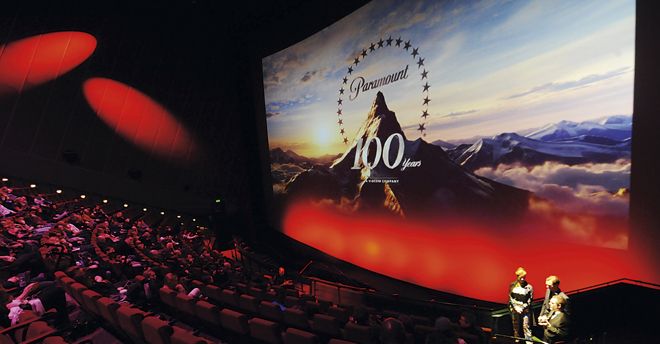
And last of all, I myself have a particular interest in low-frequency transducers. What can you tell me about your woofer drivers?
'They have a big Xmax or linear travel, four drivers per cabinet, in custom-ported designs with up to eight cabinets, depending upon the size of the theatre. There is a substantial amount of sub-bass to provide full range when you need it. We make sure you have the horsepower. We used to use eighteen-inch subs but when we made the transition from analogue to digital, we found that filmmakers were really cranking the top end for loudness and they were pushing it to ridiculous volume levels. We peak at 118dB continuous. Normally, it’ll be a 118dB peak for a moment. The trailer for Tron: Legacy for example...
'Just about every analogue system has undergone upgrades as they were never designed to take that sort of amplitude over that length of time. A filmmaker can run for ten minutes at maximum volume if they like, although we try to talk filmmakers out of that...'
IMAX AT HOME

Check out this trio of Blu-ray releases that go large...
The Dark Knight Rises
Christopher Nolan's final part of his Batman trilogy upped the IMAX quota on its predecessor by including around an hour of IMAX-shot material, presented on Warner's BD release at 1.78:1 (cropped from its original 1.44:1 but still clearly separate from the other 2.40:1 35mm footage).
Click here for our review.
Transformers: Revenge of the Fallen
Fighty robot fans in the US were treated to a special Big Screen edition Blu-ray of this 2009 blockbuster, incorporating a handful of action scenes filmed with 70mm IMAX cameras. It's a region-free release, so can be imported if you only have an R2 player.
Tron: Legacy
The long-awaited sci-fi sequel was filmed digitally using 3D rigs, but around 40 minutes was then expanded for IMAX cinemas using the company's Digital Re-Mastering wizardry. The BD release automatically switches aspect ratio (from 2.35:1 to 1.78:1) for these mind-blowing sequences.
Click here for our review.
 |
Home Cinema Choice #351 is on sale now, featuring: Samsung S95D flagship OLED TV; Ascendo loudspeakers; Pioneer VSA-LX805 AV receiver; UST projector roundup; 2024’s summer movies; Conan 4K; and more
|


